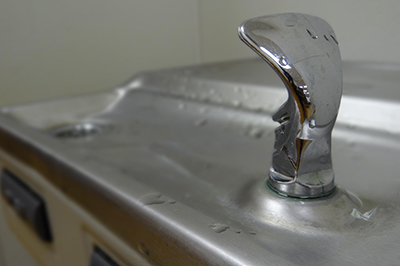By Dr. Linda Lemasters
On December 2, 2015, the Michigan Department of Health and Human Services issued a summary report on safe and unsafe blood lead levels in the children of Flint, Michigan. Children with elevated lead levels more than doubled after a change in water sources. At some point in Flint’s very public discussion, school leaders, teachers, and parents began to ask questions about the safety of the water supply in the schools their children attend. Alas, the data were not as one would hope; the Flint situation should be a wake-up call for facility managers of schools, daycares, and other public buildings children frequent across the U.S.
There are schools across the nation that must test for lead levels and other toxins, poisons, and bacteria in the water. Those are schools not on public access water supplies. Schools, however, on municipal and other public water lines are not required to test their water. This inconsistency leaves many children at risk, especially in older buildings or in situations in which water is used only sporadically and sits for long periods of time in the older pipes.
Just what are the risks of lead tainted water supplies? Dr. Jay Schneider, a neuroscientist at Thomas Jefferson University, very clearly laid out the risks of lead consumption by children in an article in Popular Science by Alexandra Ossola:
One thing is constant, however: lead is toxic, and if it makes its way into the still-developing brains of young children, many of the effects can be permanent. Lead can change how signals are passed within the brain, how memories are stored, even how cells get their energy, resulting in life-long learning disabilities, behavioral problems, and lower IQs. (Schneider, in Ossola, 2016)
As we learn more about lead and its effects on the brain, even down to these molecular levels, if anything it’s even more dangerous than we thought. It can really change the programming of the brain, which will have considerable effects on subsequent behavioral and brain function. (Schneider, in Ossola, 2016)
While I do not want to sound an alarm—I believe that has been accomplished by others—I do want to bring two questions to the reader’s attention:
- How do we go about getting water tested in all schools across the U.S., no matter what the water source is?
- What research plans do we have to find solutions for the children who already have experienced lead poisoning?
The first question seems simple enough. The testing of water sources is relatively inexpensive, with little training required for the person obtaining the samples. Even without federal and state requirements to test water, localities should be able to finance such tests. Testing does expose another question as well. Are many of the schools and facilities that would tend to have lead problems in the poorer neighborhoods and communities?
According to the research (Waxman & Thompson, 2016), counties reporting in 2014 on at least 1,000 children with poverty rates at or above the national average, 5% or more of these children had elevated blood lead levels. With only 26 states reporting, 47 counties have the same problems as Flint. This research reveals that the problem is more prevalent in poorer communities and the exposure is at astonishing rates. Advocates for funding lead testing need to be found from private sources or the states. Lead testing also may be a burden that more fiscally able communities could share.
Much of the research supports the idea that there is some level of danger of lead consumption by children, especially those children with nutritional deficiencies. The research on the harmful levels of lead in children, however, is mixed at best, with the experts often disagreeing. Some researchers contend there are no negative effects of low level, short-term lead exposure on children. Other studies found that there are mental difficulties experienced by children, with little hope of solutions for the pediatric difficulties. In addition, it is often difficult for researchers to separate and control the variables for research, which would provide significant results one way or the other.
This brings us to the second question. What research plans do we have to find solutions for the children who already have experienced lead poisoning? By way of this blog, I am calling on researchers and funding sources to consider this as a priority. Not only should we assure that all children have clean water—at school, at home, wherever they go—we also need to find assistance for those children who already have been exposed.
References:
Hanna-Attisha, M., LaChance, J., Sadler, C., & Schnepp, A. C. (2016, February). Elevated blood lead levels in children associated with the flint drinking water crisis: A spatial analysis of risk and public health response. American Journal of Public Health Research, 106(2), pp. 283-290. Downloaded on May 23, 2016 from http://ajph.aphapublications.org/doi/pdf/10.2105/AJPH.2015.303003
Ossola, A. (2016, May 17). Lead in Water: What are the health effects and dangers? The water in Flint, Michigan could affect children permanently. Popular Science. Downloaded on May 17, 2016 from http://www.popsci.com/lead-water-what-are-health-effects-dangers
Seewer, J. (2016, April 9). Water with unsafe lead amounts found in hundreds of schools. AP, The Big Story. Downloaded on May 17, 2016 from http://bigstory.ap.org/article/7ba3df3a85df46ed9c8feeaa1bf14c4f/water-unsafe-lead-amounts-found-hundreds-schools
Shell, E. R. (2016, March 22). Flint’s lead-laced water may not cause permanent brain damage in children. Scientific American. Downloaded May 17, 2016 from http://www.scientificamerican.com/article/flint-s-lead-tainted-water-may-not-cause-permanent-brain-damage/
Taking Action of Flint Water. Downloaded on May 17, 2016 from http://www.michigan.gov/documents/snyder/FWATF_FINAL_REPORT_21March2016_517805_7.pdf?20160523121255
Waxman, E., & Thompson, M. (2016, April 16). Poor nutrition leaves kids vulnerable to lead poisoning—no just in Flint. Urban Wire: Food and Nutrition. Downloaded May 18, 2016 from http://www.urban.org/urban-wire/poor-nutrition-leaves-kids-vulnerable-lead-poisoning-and-not-just-flint
More information may be found on the Education Facilities Clearinghouse website: www.efc.gwu.edu
Linda Lemasters, Director, Education Facilities Clearinghouse
Linda is an associate professor in the Graduate School of Education and Human Development of The George Washington University. Her areas of expertise and research include educational planning, facilities management, and women CEOs. She actively conducts research concerning the effects of the facility on the student and teacher, publishes within her field, and has written or edited numerous books including School Maintenance & Renovation: Administrator Policies, Practices, and Economics and book chapters including a recent chapter, Places Where Children Play, published July, 2014 in Marketing the Green School: Form, Function, and the Future.











